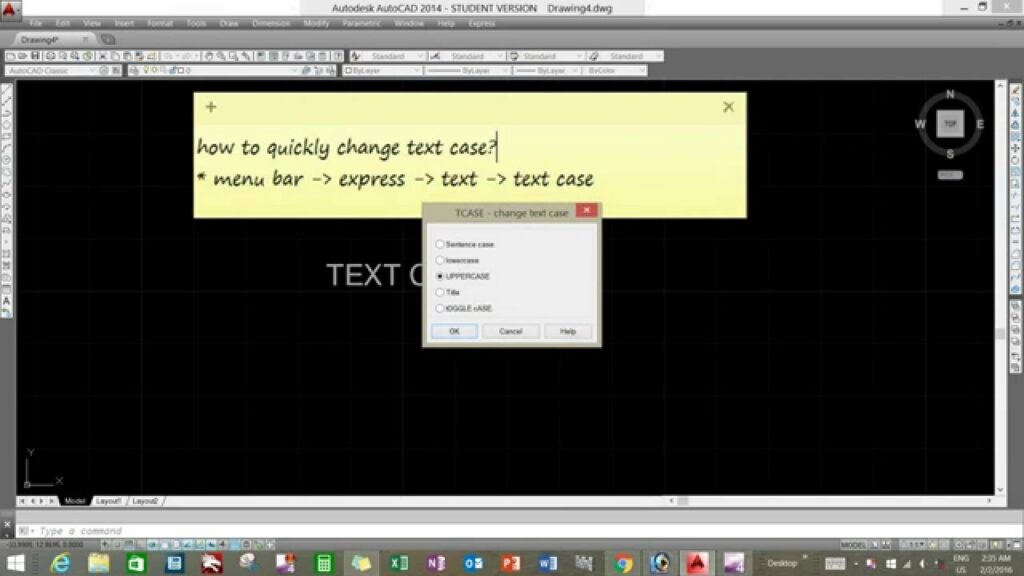Transformative Precision: A Comprehensive Guide to Quickly Changing Text Case in AutoCAD

Introduction:
AutoCAD, a leading software in the realm of computer-aided design (CAD), continues to empower architects, engineers, and designers with an extensive set of tools designed to enhance efficiency and precision. Among these tools, the ability to quickly change text case stands out as a powerful feature, streamlining the annotation and documentation process. This extensive article delves into the intricacies of changing text case in AutoCAD, exploring its functionalities, applications, and the transformative impact it has on achieving uniformity and readability within the design process.
Understanding Text Case Options in AutoCAD:
AutoCAD provides users with versatile options for changing the case of text within drawings. These options include converting text to uppercase, lowercase, title case, and sentence case. This functionality is crucial for maintaining consistency in text formatting, adhering to drawing standards, and enhancing the visual clarity of annotations.
Key Features and Functionalities:
- Uppercase Conversion: The ability to convert text to uppercase in AutoCAD is essential for creating uniformity in design annotations. Uppercase text is often used for titles, headings, or elements that require emphasis. The uppercase conversion feature ensures that text maintains a consistent and professional appearance.
- Lowercase Conversion: Lowercase text is commonly used for general annotations and descriptions. AutoCAD allows users to quickly convert text to lowercase, promoting readability and consistency throughout the drawing. This feature is particularly useful for maintaining a standardized approach to text formatting.
- Title Case Conversion: Title case is a style where the first letter of each major word is capitalized. AutoCAD’s title case conversion feature is beneficial for creating aesthetically pleasing titles, labels, or headings. It enhances the visual appeal of text elements while maintaining readability.
- Sentence Case Conversion: Sentence case involves capitalizing the first letter of a sentence while keeping the rest of the sentence in lowercase. AutoCAD’s sentence case conversion feature is useful for annotations that resemble sentence structures, providing a balanced and professional look.
Applications of Changing Text Case in AutoCAD:
- Consistent Annotation Formatting: Changing text case in AutoCAD is instrumental in maintaining consistent formatting across annotations. This is crucial for creating professional-looking drawings, where uniformity enhances the overall visual clarity and presentation.
- Standardizing Drawing Titles and Headings: Drawing titles and headings often require specific formatting to stand out. AutoCAD’s text case conversion options allow designers to standardize the presentation of titles and headings, contributing to a cohesive and polished drawing set.
- Enhancing Readability in Descriptions: Descriptive text within drawings benefits from standardized text case. By converting text to uppercase, lowercase, title case, or sentence case based on the context, designers can enhance the readability and comprehension of detailed descriptions.
- Maintaining Drawing Standards: AutoCAD’s text case features align with drawing standards and conventions. Designers can adhere to industry-specific or project-specific standards by consistently applying the appropriate text case to different types of annotations within their drawings.
Optimizing Workflow for Changing Text Case:
- Utilizing Express Tools and Commands: AutoCAD offers Express Tools that include commands for changing text case. The “TXT2MTXT” command, for instance, allows users to convert single-line text to multiline text with the option to change the case during the process.
- Leveraging AutoLISP Programs: Advanced users can explore AutoLISP programming to create custom routines for changing text case. AutoLISP programs can be tailored to specific project requirements, providing a more automated and customized approach.
- Combining Text Editing Commands: AutoCAD’s text editing commands, such as “DDEDIT” and “MTEXT,” can be combined with text case conversion options. This approach enables users to seamlessly integrate text case changes into their regular text editing workflows.
- Using the Properties Palette: The Properties palette in AutoCAD provides a user-friendly interface for modifying text properties, including text case. Designers can select text objects, open the Properties palette, and change the text case directly, simplifying the editing process.
Conclusion:
In conclusion, the ability to quickly change text case in AutoCAD is a valuable tool that contributes to precision, uniformity, and readability within the design process. As AutoCAD continues to evolve, the emphasis on features like text case conversion reflects the software’s commitment to providing users with tools that transcend traditional drafting boundaries. Embrace the power of changing text case, and witness the transformation of your AutoCAD experience into a seamless journey of efficiency, precision, and creative exploration within the vast landscape of CAD design.




